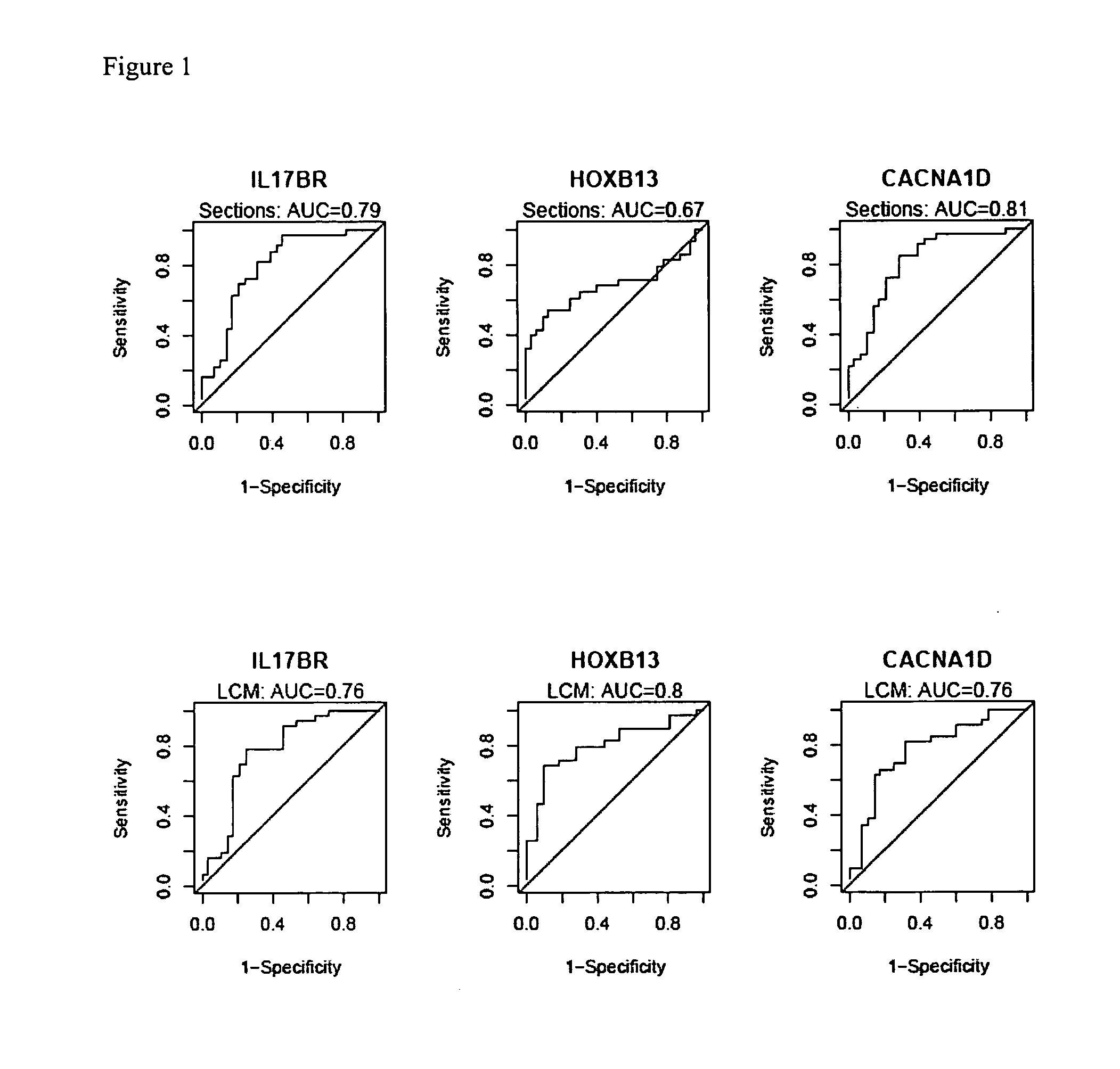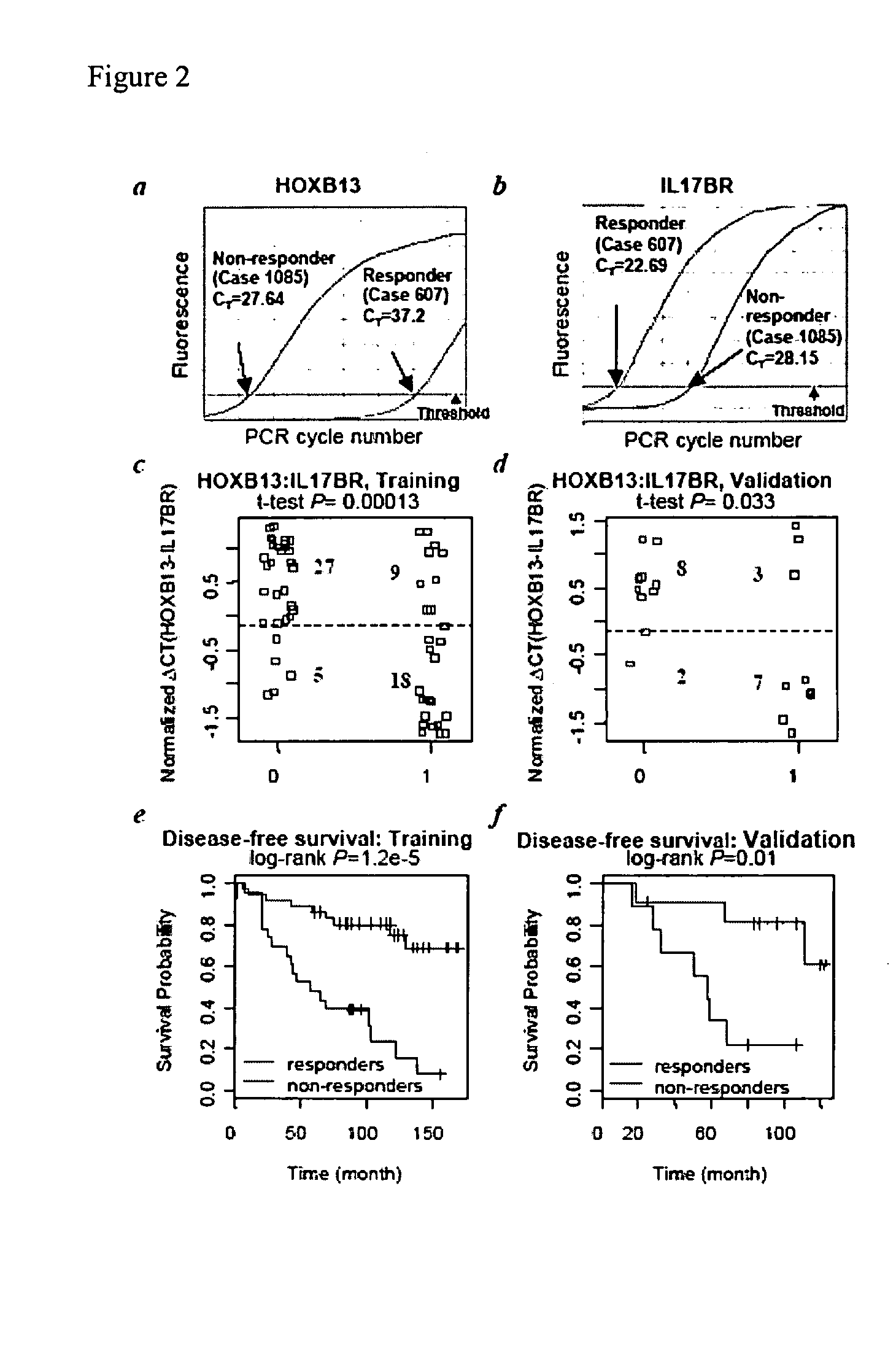Predicting breast cancer treatment outcome
- Summary
- Abstract
- Description
- Claims
- Application Information
AI Technical Summary
Benefits of technology
Problems solved by technology
Method used
Image
Examples
example 1
General Methods
[0163] Patient and Tumor Selection Criteria and Study Design
[0164] Patient inclusion criteria for this study were: Women diagnosed at the Massachusetts General Hospital (MGH) between 1987 and 2000 with ER positive breast cancer, treatment with standard breast surgery (modified radical mastectomy or lumpectomy) and radiation followed by five years of systemic adjuvant tamoxifen; no patient received chemotherapy prior to recurrence. Clinical and follow-up data were derived from the MGH tumor registry. There were no missing registry data and all available medical records were reviewed as a second tier of data confirmation.
[0165] All tumor specimens collected at the time of initial diagnosis were obtained from frozen and formalin fixed paraffin-embedded (FFPE) tissue repositories at the Massachusetts General Hospital. Tumor samples with greater than 20% tumor cells were selected with a median of greater than 75% for all samples. Each sample was evaluated for the follow...
example 2
Identification of Differentially Expressed Genes
[0177] Gene expression profiling was performed using a 22,000-gene oligonucleotide microarray as described above. In the initial analysis, isolated RNA from frozen tumor-tissue sections taken from the archived primary biopsies were used. The resulting expression dataset was first filtered based on overall variance of each gene with the top 5,475 high-variance genes (75th percentile) selected for further analysis. Using this reduced dataset, t-test was performed on each gene comparing the tamoxifen responders and non-responders, leading to identification of 19 differentially expressed genes at the P value cutoff of 0.001 (Table 2). The probability of selecting this many or more differentially expressed genes by chance was estimated to be 0.04 by randomly permuting the patient class with respect to treatment outcome and repeating the t-test procedure 2,000 times. This analysis thus demonstrated the existence of statistically significant...
example 3
Identification of the HOXB13:IL17BR Expression Ratio
[0184] HOXB13:IL17BR expression ratio was identified as a robust composite predictor of outcome as follows. Since HOXB13 and IL17BR have opposing patterns of expression, the expression ratio of HOXB13 over IL17BR was examined to determine whether it provides a better composite predictor of tamoxifen response. Indeed, both t-test and ROC analyses demonstrated that the two-gene ratio had a stronger correlation with treatment outcome than either gene alone, both in the whole tissue sections and LCM datasets (see Table 5). AUC values for HOXB13:IL17BR reached 0.81 for the tissue sections dataset and 0.84 for the LCM dataset. Pairing HOXB13 with CACNA1D or analysis of all three markers together did not provide additional predictive power.
TABLE 5HOXB13:IL17BR ratio is a stronger predictorof treatment outcomet-testROCt-statisticP valueAUCP valueTissueIL17BR4.151.15E−040.791.58E−06SectionHOXB13−3.571.03E−030.670.01HOXB13:IL17BR−4.911.48...
PUM
| Property | Measurement | Unit |
|---|---|---|
| Ratio | aaaaa | aaaaa |
| Level | aaaaa | aaaaa |
Abstract
Description
Claims
Application Information
 Login to View More
Login to View More - R&D
- Intellectual Property
- Life Sciences
- Materials
- Tech Scout
- Unparalleled Data Quality
- Higher Quality Content
- 60% Fewer Hallucinations
Browse by: Latest US Patents, China's latest patents, Technical Efficacy Thesaurus, Application Domain, Technology Topic, Popular Technical Reports.
© 2025 PatSnap. All rights reserved.Legal|Privacy policy|Modern Slavery Act Transparency Statement|Sitemap|About US| Contact US: help@patsnap.com


